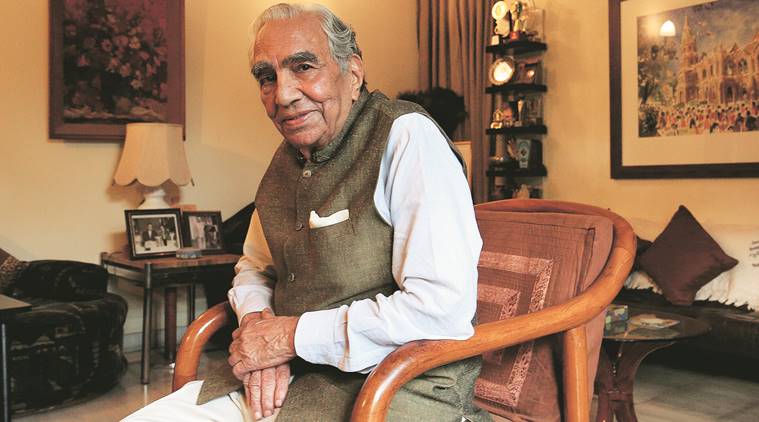 The late Pran Nevile at his Gurugram residence. (Express photo by Amit Mehra)
The late Pran Nevile at his Gurugram residence. (Express photo by Amit Mehra)
Last month, at the conclusion of the 100th birth anniversary celebrations of thumri and ghazal exponent Naina Devi, organised by her friend and author Pran Nevile at Delhi’s India International Centre (IIC), a handful of people — including Naina Devi’s daughter and grandchildren — sat in quiet disbelief and heard the ghazal Tabiyat… behlayi nahi jaati — a private recording from the ’50s that was created on a portable recorder that Nevile had picked up in Tokyo. His stint with the foreign service and later the UN allowed him to travel a lot.
At the IIC, Nevile climbed the stairs sans any support, grabbed the microphone and said, “An old recording, this is from 1955. Apart from thumri, dadra and chaiti, Naina Devi also sang ghazal. It is not so well-known because very few ghazals by her were recorded. I consider it my responsibility to make the younger audience aware of this fine artiste of our times,” said the 95-year-old, who also presented young singer Poonam Chauhan, who sang some from Naina Devi’s repertoire.
This was last month. Nevile, the “Lahori” in India, passed away on Thursday morning. Almost a week before that, he was sitting across a water colour of Government College University, Lahore (his alma mater), at his Gurugram home. “I’m the oldest living author in the country,” he had said, adding, “but I still manage to get along with teenagers of today”. His last book was Marvels of Indian Painting: Rise and Demise of Company School (2007). Others included KL Saigal – Immortal Singer and Superstar (2006), Beyond the Veil – Indian Women in the Raj (2005) and Stories from the Raj – Sahibs, Memsahibs and Others (2004) and the more popular, Nautch Girls of India.
Nevile’s life changed when he met Naina Devi for the first time in 1953 and was “enchanted” by the thumris he heard. “I wasn’t mesmerised, I was enchanted. Her voice came from another world,” he said. This parallel world, for Nevile, was perhaps a reminder of Lahore’s infamous Heera Mandi, where he heard beguiling melodies by noted courtesans as a young man. “There was music then, and naach or nautch, as it was called by the British, wasn’t happening anymore,” said Nevile.
“Naina ji was not just a musician but also a dear friend who was deeply saddened by the plight of the singing and dancing girls and would always rue the sanitisation drive (anti-nautch movement) in the country. She wasn’t from their world but learned from them,” said Nevile, whose book Nautch Girls of India (1999), was inspired by Naina Devi. The book, written over seven years of research in libraries in the US and UK, remains one of the most extensive accounts of the tawaifs.
“After the mujra, Naina Devi would call them and ask about a particular taan,” said Nevile. After her husband died, she moved to Delhi, and began to perform these love songs, romantic poetry that spoke of desire, and became one of the finest thumri singers of our country. Her home baithaks at her Pusa Road and then Kaka Nagar residence became very popular among musicians. It is at one of these baithaks that Nevile was also introduced to Begum Akhtar and became an ardent devotee. At her centenary celebrations in 2014, he released his private rercordings of Mallika-e-ghazal through an album. That is the first time the audience heard the thumri Darshan bina taras rahi girdhari and a dadra, Ka leke hayebe gawanwa, which weren’t recorded otherwise.
“The word tawaif deserves respect, not disdain. A lot of them were singers and not sex workers. People think of them as prostitutes, undermining their value as great musicians. The missionaries dubbed them as fallen women, which they were not. The Western-educated Indians, who wrote later, were influenced by these writings and wrote the same. There was no patronage and the institution collapsed,” said Nevile. He mentions a time, post-1947, when the tawaifs weren’t allowed to enter the premises of All India Radio until they produced a marriage certificate.
But what remains most well-known besides Nautch Girls of India, is Lahore, A Sentimental Journey (1993), reminiscent of his longing for the homeland. Fitting, as Lahore towers most conversations one has with Nevile, who did not go back to the city for many years after the Partition despite visits to Pakistan. “I didn’t think I could reconcile with the changes my birthplace would have gone through,” he said. He launched the book at Lahore’s Government College University, with more than a thousand attending the launch. “I’m a Lahori. So I’m more well-known in Pakistan than in India,” he said with a laugh.
He then turned to an oil-on-canvas of Tilly Kettle from 1772 in Faizabad, which has a nautch girl loaded with ornaments, one he found at a library in the UK, and which he used in his book. “It remains one of the most glamorous photos from those times. In all these years, I’ve realised that one needs to give these women their due respect. And I plan to keep speaking on their behalf,” he had said. He won’t speak to us anymore, but his writings will be a reminder of a significant past.